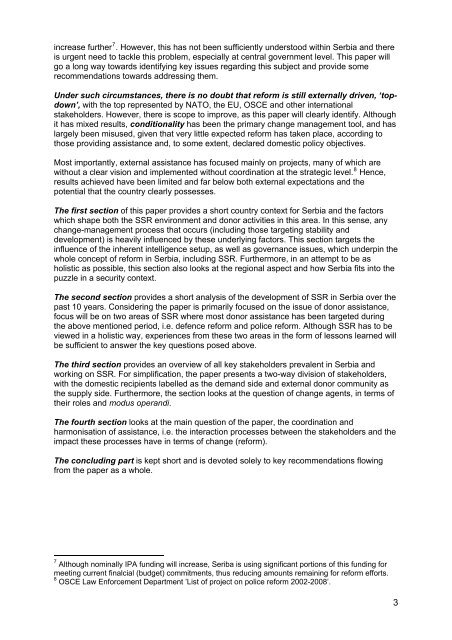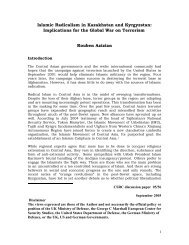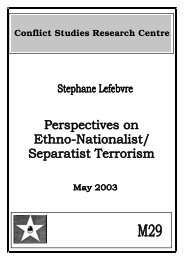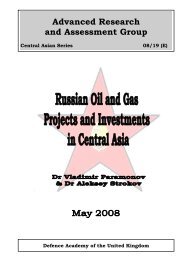Furthermore, by look<strong>in</strong>g at these two areas of SSR, it is more <strong>in</strong> l<strong>in</strong>e with the Lisbon Treaty’sprovisions on this theme. 2The question of evaluation is relevant to the context of this paper, as it is necessary to def<strong>in</strong>ewhether it is donor dem<strong>and</strong>s (expectations) or the legitimate policy objectives of the recipientcountry that is be<strong>in</strong>g assessed. In other words, should success be measured aga<strong>in</strong>st whatthe host country desires, or aga<strong>in</strong>st the expectations placed by external stakeholders. Thispaper has opted to measure actual reform progress aga<strong>in</strong>st the publicly stated policy aims ofthe <strong>Serbia</strong>n government. In police reform this refers to requirements related to EU<strong>in</strong>tegration, whilst <strong>in</strong> the field of defence reform this refers to closer Euro-Atlantic <strong>in</strong>tegration,despite the recent lack of a clear NATO policy stance.Chris Donnelly, a former special advisor to NATO <strong>and</strong> someone deeply <strong>in</strong>volved <strong>in</strong> NATOaccession <strong>and</strong> reform <strong>in</strong> CE Europe, correctly states that SSR is becom<strong>in</strong>g <strong>in</strong>creas<strong>in</strong>glycomplex to evaluate 3 . No longer does evaluation focus on the conversion of armed forces<strong>and</strong> overcom<strong>in</strong>g legacies from the past. It now has more to do with address<strong>in</strong>g societalreform, technology reform, <strong>in</strong>formation reform <strong>and</strong> a fundamental change <strong>in</strong> the nature ofconflict <strong>and</strong> security.<strong>Serbia</strong> is firmly <strong>in</strong> the so-called ‘first generation’ of the SSR process 4 , <strong>and</strong> has, contrary toexpectations, somehow lost <strong>in</strong> its attempts to enter the ‘second generation’, as arguedbelow 5 . In other words, responsibility for this lack of progress must ultimately rest with thelack of a clear vision <strong>and</strong> capacity for the implementation of politically declared goals.Furthermore, if reform is to advance, it entails change. This requires change agents, whichare not always visible <strong>in</strong> <strong>Serbia</strong> (at least not <strong>in</strong> terms of required critical mass at the highestlevels), thus mak<strong>in</strong>g jo<strong>in</strong>t development of programmes with local ownership difficult.Operational th<strong>in</strong>k<strong>in</strong>g <strong>and</strong> the ad-hoc ‘fire-ext<strong>in</strong>guish<strong>in</strong>g’ modus oper<strong>and</strong>i is furtherburden<strong>in</strong>g the process, with hard strategic decisions be<strong>in</strong>g postponed.While some argue that there is a general lack of political will (or <strong>in</strong>terest) <strong>in</strong> <strong>Serbia</strong> toadvance reforms <strong>and</strong> <strong>in</strong>troduce required change, this argument can also be presented onbehalf of the donors, reflected <strong>in</strong> several respects, <strong>in</strong>clud<strong>in</strong>g lack of consistency <strong>and</strong>common SSR strategy. As <strong>in</strong>ternational attention is mov<strong>in</strong>g away from the WesternBalkans, so is <strong>in</strong>vestment <strong>in</strong>to the region, <strong>in</strong>clud<strong>in</strong>g <strong>Serbia</strong> 6 . Countries which have been keystakeholders over the past decades are simply not prioritis<strong>in</strong>g <strong>Serbia</strong> as they once did, whichis certa<strong>in</strong>ly hav<strong>in</strong>g a negative impact, as desirable reforms did not take place when <strong>in</strong>itiallyexpected or planned.<strong>Serbia</strong> is not an aid-dependent country <strong>in</strong> terms of the level of assistance received.However, <strong>in</strong> terms of effect, external assistance has a very important role to play with<strong>in</strong> thereform process, <strong>in</strong>clud<strong>in</strong>g SSR. Consider<strong>in</strong>g the current f<strong>in</strong>ancial crisis <strong>and</strong> the significantreduction <strong>in</strong> the amount of assistance received from the EU <strong>in</strong> the form of Instruments forPre-Accession <strong>Assistance</strong> (IPA), the role of other bilateral <strong>and</strong> multilateral assistance will2 The Lisbon Treaty, as it will become known after its formal signature <strong>in</strong> the Portuguese capital on 13December 2007, also further def<strong>in</strong>es the 'Petersberg' tasks to <strong>in</strong>clude Jo<strong>in</strong>t Disarmament Operations <strong>and</strong> <strong>Security</strong><strong>Sector</strong> <strong>Reform</strong>.3 Chris Donnelly, ‘Learn<strong>in</strong>g for SSR <strong>in</strong> CE Europe’, <strong>in</strong> Alan Bryden & He<strong>in</strong>er Hänggi, <strong>Reform</strong> <strong>and</strong>Reconstruction of the <strong>Security</strong> <strong>Sector</strong>, DCAF 2004, p.47.4 For more on SSR <strong>and</strong> the first & second generation argument see Page 9, Footnote 13.5 This measurement is based on a fixed time frame <strong>and</strong> achieved outputs benchmarked aga<strong>in</strong>st statedpolicy objectives. For a debate on measur<strong>in</strong>g SSR progress, see Miroslav Hadžić, ’Measur<strong>in</strong>g theextent of SSR <strong>in</strong> <strong>Serbia</strong>: Fram<strong>in</strong>g the problem’ <strong>in</strong> the Western Balkans <strong>Security</strong> Observer Issue 7-8,CCMR Belgrade 2007, Belgrade.6 It is <strong>in</strong>terest<strong>in</strong>g to note that <strong>Serbia</strong> has received a larger share than neighbour<strong>in</strong>g countries <strong>in</strong> termsof donor assistance towards the public sector, but far less <strong>in</strong>vestment <strong>in</strong> the private sector, as thecountry is still seen as highly risky, especially <strong>in</strong> terms of bureaucracy <strong>and</strong> stable legislative ground<strong>in</strong>g.2
<strong>in</strong>crease further 7 . However, this has not been sufficiently understood with<strong>in</strong> <strong>Serbia</strong> <strong>and</strong> thereis urgent need to tackle this problem, especially at central government level. This paper willgo a long way towards identify<strong>in</strong>g key issues regard<strong>in</strong>g this subject <strong>and</strong> provide somerecommendations towards address<strong>in</strong>g them.Under such circumstances, there is no doubt that reform is still externally driven, ‘topdown’,with the top represented by NATO, the EU, OSCE <strong>and</strong> other <strong>in</strong>ternationalstakeholders. However, there is scope to improve, as this paper will clearly identify. Althoughit has mixed results, conditionality has been the primary change management tool, <strong>and</strong> haslargely been misused, given that very little expected reform has taken place, accord<strong>in</strong>g tothose provid<strong>in</strong>g assistance <strong>and</strong>, to some extent, declared domestic policy objectives.Most importantly, external assistance has focused ma<strong>in</strong>ly on projects, many of which arewithout a clear vision <strong>and</strong> implemented without coord<strong>in</strong>ation at the strategic level. 8 Hence,results achieved have been limited <strong>and</strong> far below both external expectations <strong>and</strong> thepotential that the country clearly possesses.The first section of this paper provides a short country context for <strong>Serbia</strong> <strong>and</strong> the factorswhich shape both the SSR environment <strong>and</strong> donor activities <strong>in</strong> this area. In this sense, anychange-management process that occurs (<strong>in</strong>clud<strong>in</strong>g those target<strong>in</strong>g stability <strong>and</strong>development) is heavily <strong>in</strong>fluenced by these underly<strong>in</strong>g factors. This section targets the<strong>in</strong>fluence of the <strong>in</strong>herent <strong>in</strong>telligence setup, as well as governance issues, which underp<strong>in</strong> thewhole concept of reform <strong>in</strong> <strong>Serbia</strong>, <strong>in</strong>clud<strong>in</strong>g SSR. Furthermore, <strong>in</strong> an attempt to be asholistic as possible, this section also looks at the regional aspect <strong>and</strong> how <strong>Serbia</strong> fits <strong>in</strong>to thepuzzle <strong>in</strong> a security context.The second section provides a short analysis of the development of SSR <strong>in</strong> <strong>Serbia</strong> over thepast 10 years. Consider<strong>in</strong>g the paper is primarily focused on the issue of donor assistance,focus will be on two areas of SSR where most donor assistance has been targeted dur<strong>in</strong>gthe above mentioned period, i.e. defence reform <strong>and</strong> police reform. Although SSR has to beviewed <strong>in</strong> a holistic way, experiences from these two areas <strong>in</strong> the form of lessons learned willbe sufficient to answer the key questions posed above.The third section provides an overview of all key stakeholders prevalent <strong>in</strong> <strong>Serbia</strong> <strong>and</strong>work<strong>in</strong>g on SSR. For simplification, the paper presents a two-way division of stakeholders,with the domestic recipients labelled as the dem<strong>and</strong> side <strong>and</strong> external donor community asthe supply side. Furthermore, the section looks at the question of change agents, <strong>in</strong> terms oftheir roles <strong>and</strong> modus oper<strong>and</strong>i.The fourth section looks at the ma<strong>in</strong> question of the paper, the coord<strong>in</strong>ation <strong>and</strong>harmonisation of assistance, i.e. the <strong>in</strong>teraction processes between the stakeholders <strong>and</strong> theimpact these processes have <strong>in</strong> terms of change (reform).The conclud<strong>in</strong>g part is kept short <strong>and</strong> is devoted solely to key recommendations flow<strong>in</strong>gfrom the paper as a whole.7 Although nom<strong>in</strong>ally IPA fund<strong>in</strong>g will <strong>in</strong>crease, Seriba is us<strong>in</strong>g significant portions of this fund<strong>in</strong>g formeet<strong>in</strong>g current f<strong>in</strong>alcial (budget) commitments, thus reduc<strong>in</strong>g amounts rema<strong>in</strong><strong>in</strong>g for reform efforts.8 OSCE Law Enforcement Department ’List of project on police reform 2002-2008’.3
















